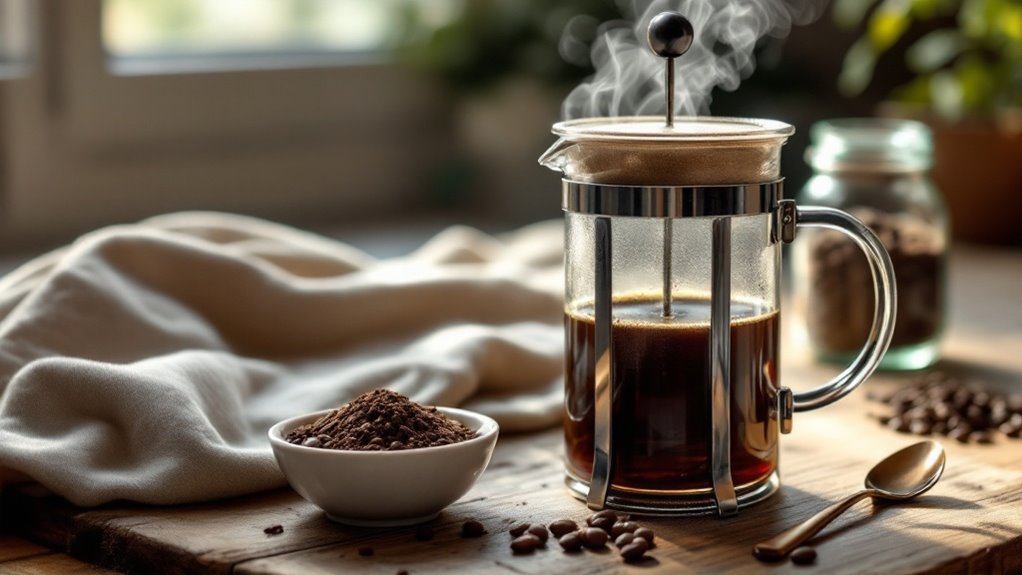







The microwave, often seen as a shortcut to convenience, can transform your morning ritual into a surprisingly refined experience. You might think brewing coffee in a microwave sacrifices quality, but with the right technique, you can craft a cup that rivals your favorite café. From choosing the perfect grind to mastering the art of frothing milk, there's more to it than just pressing a button. What if the secret to a rich, aromatic brew lies in a few simple steps you've overlooked? The answer might just change how you approach your next cup.
Key Takeaways
- Use a microwave-safe mug and heat water to 195–205°F for optimal coffee extraction.
- Add 1-2 tablespoons of ground coffee or 1-2 teaspoons of instant coffee per 8 oz of water.
- Steep ground coffee for 3-4 minutes and strain through a filter or cheesecloth for a smooth brew.
- Froth milk in a microwave-safe jar by shaking vigorously and microwaving for 30 seconds for creamy foam.
- Reheat coffee in 20-30 second intervals, stirring thoroughly to ensure even heat distribution and prevent superheating.
Essential Tools and Ingredients for Microwave Coffee
To make coffee in a microwave, you'll need a few essential tools and ingredients to secure a flavorful and hassle-free brew. Start with a microwave-safe mug, ideally made of ceramic or glass, as these materials promote even heat distribution and prevent cracking under high temperatures. Avoid using metal or plastic mugs, as they can warp or leach unwanted flavors into your coffee. For the best taste, use freshly ground coffee beans with a medium to coarse grind, which allows for ideal extraction without over-extracting bitter compounds. If you don't have a grinder, pre-ground coffee works, but it won't match the aromatic depth of freshly ground coffee beans.
Filtered water is vital, as impurities in tap water can dull the coffee's flavor. Heat the water in your microwave until it's just below boiling, around 195–205°F, to avoid scorching the grounds. You'll also need a filter or cheesecloth to hold the ground coffee, preventing sludge from ending up in your mug. With these tools and ingredients, you're set to brew a clean, flavorful cup of microwave coffee.
Step-by-Step Guide to Brewing Microwave Coffee
Brewing coffee in a microwave combines simplicity with precision to deliver a satisfying cup. To make coffee, start by filling a microwave-safe mug with cold water, leaving about an inch of space at the top. Heat the water on high for 1-2 minutes, checking every 20 seconds to confirm it reaches the ideal temperature of 195°F–205°F. Overheating can scorch the coffee grounds, so monitor carefully. Once heated, add 1-2 teaspoons of instant coffee or 1-2 tablespoons of ground coffee per 8 oz of water, stirring thoroughly to dissolve or evenly distribute the coffee grounds. If using ground coffee, let it steep for 3-4 minutes to extract full flavor. Strain the mixture through a filter or cheesecloth to remove the grounds, guaranteeing a smooth, grit-free hot cup of coffee. Customize your microwave coffee by stirring in sugar, cinnamon, or vanilla extract to enhance the flavor. These steps to make coffee in the microwave confirm a quick, flavorful brew without compromising quality.
How to Froth Milk in the Microwave
With just a microwave and a jar, you can create velvety frothed milk to elevate your coffee experience. Start by filling a microwave-safe jar halfway with milk, leaving ample space for foam to form. Non-fat milk works exceptionally well, yielding surprisingly creamy foam, though whole, 2%, or non-dairy alternatives like oat or almond milk can also produce rich textures. Secure the jar's lid tightly and shake vigorously for 30-40 seconds until the milk doubles in volume and froth forms. Remove the lid and microwave the jar for 30 seconds to stabilize the foam, allowing it to rise to the top. Avoid overfilling the jar to prevent spills and guarantee even frothing. Once microwaved, the foam will separate, creating a luxurious layer atop the warm milk. Pour the frothed milk immediately into your coffee, blending the creamy foam with the brew for a café-style finish. This method is quick, efficient, and delivers a professional-quality texture without specialized equipment. Experiment with different milk types to tailor the flavor and consistency to your preference, enhancing your microwave-brewed coffee with a touch of indulgence.
Using Coffee Filters for Microwave Brewing
Choose a paper coffee filter or a reusable alternative like cheesecloth, ensuring it's large enough to hold your grounds without tearing. Secure the filter tightly with a binder clip or knot to prevent grounds from escaping, which can muddy the brew's flavor and texture. After steeping, promptly remove the filter to avoid over-extraction, preserving the coffee's balanced taste and aromatic profile.
Choosing the Right Filter
For microwave coffee brewing, selecting the right filter is essential to secure a clean, flavorful cup. Start by choosing a paper coffee filter or cheesecloth, both of which effectively hold ground coffee while preventing grounds from escaping into the water. If using a paper filter, fold it into a secure bag shape, add your ground coffee, and seal them shut with a binder clip to avoid spills and maintain cleanliness. Cheesecloth, on the other hand, is a reusable alternative, making it an eco-friendly option for those looking to reduce waste. Make sure the filter or cheesecloth is sturdy enough to withstand the brewing process without tearing, as this could lead to grounds contaminating your brew. Avoid metal filters or utensils, as they can cause sparks or damage your microwave. By selecting the right filter and preparing it properly, you'll guarantee a smooth, rich cup of coffee every time.
Proper Filter Placement
Once you've prepared your coffee filter by folding it into a bag shape and securing it with a binder clip, the next step is proper placement in your microwave-safe mug. Fill the mug with hot water, making certain it's about three-quarters full to leave room for the filter bag. Gently lower the filter bag containing two tablespoons of ground coffee into the water, making sure it's fully submerged. This guarantees even extraction, which is vital for a balanced flavor. Avoid overfilling the filter bag, as excess grounds can spill into the water, leading to a bitter taste or uneven brewing. Position the binder clip so it rests on the rim of the mug, keeping the filter bag stable during heating. Use only microwave-safe materials for both the filter and mug to prevent melting or chemical leaching. Once placed, microwave the setup for 3-4 minutes, monitoring to avoid over-extraction, which can result in a bitter or unpleasant flavor. Proper placement guarantees a clean, flavorful cup every time.
Filter Maintenance Tips
To keep your microwave-brewed coffee tasting fresh and clean, maintaining your coffee filter is essential. Start by using a high-quality paper coffee filter to guarantee proper filtration and prevent tearing during steeping. Secure the filter tightly with a binder clip or fold it carefully to avoid grounds escaping into your brew, which can disrupt even extraction and introduce unwanted bitterness. After each use, replace the paper coffee filter to maintain hygiene and prevent residual flavors from lingering, which can compromise the flavor of future batches. Avoid overfilling the filter with coffee grounds, as this can lead to overflow and uneven extraction, resulting in a weaker or inconsistent brew. Before brewing, rinse the filter with hot water to eliminate any papery taste, securing a cleaner, more flavorful cup. Proper maintenance of your coffee filter not only enhances the quality of your microwave-brewed coffee but also extends the lifespan of your brewing setup, keeping it efficient and reliable.
Tips for Perfect Microwave Coffee Every Time
Achieving a consistently delicious cup of microwave coffee starts with quality ingredients and careful technique. To make hot, flavorful microwaved coffee, begin with freshly ground beans, using a medium to coarse grind to avoid over-extraction. Heat water in a microwave-safe mug for 1-2 minutes at 90% power to prevent superheating and guarantee even heat distribution. Add a non-metallic utensil, like a wooden stick, to the mug to minimize hotspots and promote uniform brewing. Once the water is hot, stir in your coffee grounds and steep for 3-4 minutes, gently stirring once to enhance extraction without bitterness. For a quick and easy upgrade, experiment with milk frothing: shake milk in a jar, then microwave it for 30 seconds to create a creamy texture. These simple steps secure your perfect microwaved coffee is rich, balanced, and satisfying every time. By focusing on precise heat control and quality ingredients, you'll elevate your making coffee routine into a reliable, flavor-focused experience.
Pros and Cons of Microwave Coffee
Microwave coffee offers a handful of advantages and drawbacks that can influence your brewing experience. On the positive side, it's quick and convenient, perfect for busy mornings or when you don't have access to traditional brewing methods. You only need a microwave-safe mug, water, and coffee grounds, making it a cost-effective alternative to investing in expensive equipment. It's also ideal for single servings, allowing you to brew just enough without waste. However, microwave coffee has its limitations. Uneven heating can lead to inconsistent flavor extraction, resulting in a cup that lacks the depth and richness achieved with methods like pour-over or French press. Additionally, superheating risks—where water heats beyond boiling without visible bubbles—can pose safety concerns if not handled carefully. While microwave coffee is practical, it may not deliver the nuanced flavors or aromatic complexity of traditional brewing methods. If you prioritize speed and simplicity over flavor refinement, it's a viable option, but for a more satisfying coffee experience, you might find it falls short.
Reheating Coffee Safely in the Microwave
Reheating coffee in the microwave can be a practical solution when your brew has cooled, but it requires careful attention to preserve its flavor and guarantee safety. Start by transferring your coffee into a microwave-safe mug to prevent damage or chemical leaching. Heat coffee in 20-30 second intervals to avoid overheating, which can scorch the beans and create a bitter taste. Between each interval, stir coffee thoroughly to distribute heat evenly and eliminate hot spots. If your microwave has a beverage setting, use it to achieve the ideal temperature range of 195°F–205°F, ensuring your coffee retains its best possible flavor profile. Avoid reheating coffee that's been left at room temperature for over two hours, as this can promote bacterial growth and compromise safety. By following these steps, you'll maintain the integrity of your coffee's flavor while ensuring it's heated safely and efficiently. Precision and patience are key to enjoying a reheated cup that tastes as close to freshly brewed as possible.
Enhancing Flavor With Add-Ins and Spices
To elevate your microwave-brewed coffee, consider experimenting with a variety of add-ins and spices that can transform its flavor profile. Start by adding a pinch of cinnamon or nutmeg directly to your coffee grounds before microwaving. These spices infuse the brew with warm, aromatic notes that complement the coffee's natural richness. After brewing, stir in a teaspoon of vanilla extract for a smooth, sweet undertone or a dash of cocoa powder for a chocolatey depth. For a more adventurous twist, incorporate cardamom or ginger into the grounds for a subtly spicy, complex flavor. Sweeten your coffee with honey or maple syrup instead of sugar to introduce a natural, nuanced sweetness that enhances the overall taste. If you prefer a bolder flavor, try flavored syrups like caramel or hazelnut, which can be stirred in after microwaving for a customized experience. These simple yet impactful additions allow you to tailor your microwave coffee to your preferences, creating a drink that's both unique and satisfying.
Alternative Methods for Microwave Coffee Brewing
While experimenting with spices and add-ins can elevate your microwave coffee, there are also alternative brewing methods that can enhance its quality and flavor. To make the best coffee in a microwave, try using a paper coffee filter filled with ground coffee. Seal it with a binder clip, place it in a coffee mug, and steep it in microwaved hot water for 3-4 minutes. This method extracts rich flavors without the need for specialized equipment. Alternatively, you can microwave water separately and pour it over coffee grounds in a makeshift pour-over setup using a clean bar towel or cheesecloth as a filter. For a quick cappuccino-style drink, mix instant coffee with milk and sugar in a microwave-safe mug, then heat it in the microwave oven. If you prefer a traditional brewing experience, use a French press with microwaved water. These methods allow you to enjoy hot coffee with minimal effort while maximizing flavor. By using the microwave creatively, you can achieve a variety of coffee-making results tailored to your taste.
Disclosure: As an Amazon Associate, I earn from qualifying purchases.





